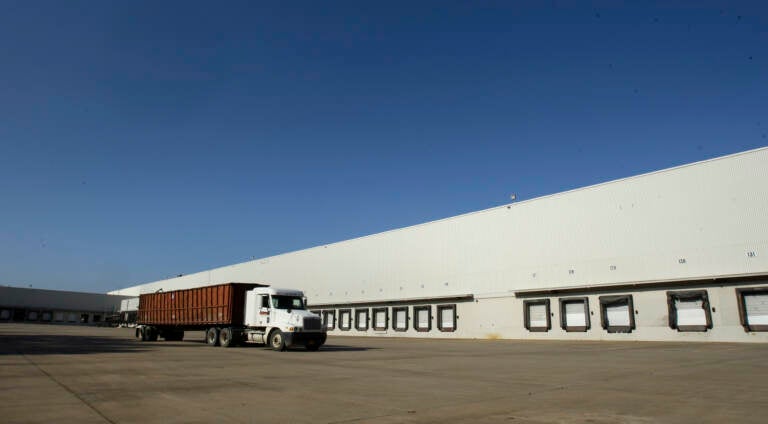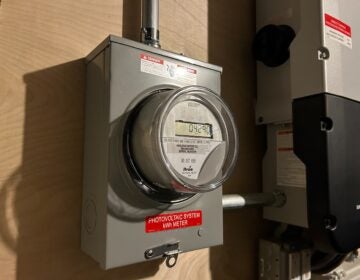Environmental org creates tool to help municipalities regulate warehouse development
A model ordinance released by PennFuture aims to limit impacts like truck traffic and increased stormwater runoff.

A truck drives past loading docks at a distribution center. (AP Photo/Danny Johnston)
This story is part of the WHYY News Climate Desk, bringing you news and solutions for our changing region.
From the Poconos to the Jersey Shore to the mouth of the Delaware Bay, what do you want to know about climate change? What would you like us to cover? Get in touch.
Truck terminals close to highways. Bathrooms for truck drivers. Forested buffers between warehouses and streams.
These are requirements that municipalities should put in place before companies like Amazon come to town, says the environmental advocacy nonprofit PennFuture.
“These facilities … will have significant impacts on the communities they’re built in and the environment,” said PennFuture attorney Brigitte Meyer, who wrote a model ordinance and guidebook to help municipalities address the impacts of the modern logistics industry. “It’s not just one or two deliveries a day, it’s constantly in and out with the goods.”
The model zoning ordinance and guidebook PennFuture released Tuesday spells out specific guardrails for development of warehousing and distribution facilities that the group hopes municipalities statewide could adopt.
The ordinance is most applicable in places that are good candidates for warehouses and distribution centers, Meyer said, with abundant, cheap, undeveloped land, access to highways and major population centers, and an available labor force.
“The real epicenter, ground zero, is in the Lehigh Valley,” Meyer said. “Probably going on 10 years at least at this point, it’s really been sort of transformed into the logistics hub of the East Coast.”
Between 2011 and 2022, more than 2 billion square feet of new warehouse space came to market nationwide. But in recent months, warehousing demand may have started to cool.
In Philadelphia, where little undeveloped land is available, warehousing and distribution centers have been proposed on former industrial sites in Southwest and South Philly, including at the former PES refinery. Amazon plans to open its largest distribution center in the city, located in Southwest Philly, this fall.
PennFuture’s guidelines distinguish between old fashioned warehouses, built for long-term storage of goods, and modern distribution and fulfillment centers, which are primarily focused on shipping. One way the model ordinance may differ from the zoning rules municipalities already have in place is that it regulates facilities based not on these use distinctions, but on the size and potential traffic associated with facilities.
“So if this is a large logistics use, it is subject to restrictions that are intended to mitigate the impact of the size,” Meyer said. “If it is a truck terminal that generates a lot of traffic, it is subject to restrictions that are intended to mitigate the traffic impacts.”
The exhaust from trucks that run on diesel fuel contains toxic air contaminants and super fine particles that can exacerbate lung issues like asthma and heart problems. Long-term exposure to diesel exhaust has even been linked to cancer. Tires and brakes also produce dangerous air pollution.
The ordinance attempts to limit truck traffic on local roads and through residential areas by requiring that truck terminals be located no more than half a mile from an expressway.
It also attempts to limit the impact of truck traffic on schools, hospitals, prisons, and other concentrations of people that could be vulnerable to poor air quality, by requiring that loading docks at warehouses over a certain size be located at least 300 feet away from these so-called “sensitive receptors.”
PennFuture recommends that municipalities categorize truck terminals as “conditional uses,” requiring traffic impact studies, additional review, and a chance for the public to weigh in before they’re permitted.
PennFuture’s model ordinance requires all warehouses to build chargers for electric vehicles, which do not emit exhaust, but only for passenger cars — not for the trucks that transport goods to and from facilities.
“The beauty of the model ordinance is that it can be added to, modified by any municipality,” Meyer said. “So if that is something that is a significant concern for somebody, it can be added in there.”
The model ordinance requires truck terminals provide amenities for truck drivers including parking, bathrooms, a break room, and vending machines.
“That helps minimize the amount of driving on the roadways, because if they can’t stay put, take their needed time off at the facility, they have to drive around and find somewhere else,” Meyer said.
PennFuture recommends municipalities avoid permitting logistics uses in already overburdened environmental justice communities. Under the model ordinance, large warehouses would need to perform environmental and community impact analyses.
One environmental impact warehouses built on previously undeveloped land can have is increased stormwater runoff due to the clearing of vegetation and paving of surfaces. The Lehigh River has been called one of the most endangered in the U.S. due to nearby warehouse development.
“What that leads to is an increased volume and velocity of stormwater runoff,” Meyer said. “It will increase the temperature of this runoff because the water is no longer falling onto trees or onto soil. … There’s also the introduction of pollutants, most notably things like road salt.”
PennFuture’s model ordinance requires all warehouses or logistics centers maintain or create forested buffers along any waterways and cut down no more than half of the mature trees on the property.
Some considerations in PennFuture’s model ordinance are already part of Philly’s zoning rules, while others are not. For example, Philly already requires that all development leave 50-foot buffers along waterways, and the city recently expanded requirements for developers around preserving and planting trees.
But there is no requirement that truck terminals be located close to expressways, and some by-right warehousing and logistics centers in Philly are more than a half mile away from these major roadways, said Bruce Bohri, a spokesperson for Philadelphia’s Department of Planning and Development in an emailed response to questions.
Requirements that logistics centers provide amenities for truck drivers are not currently in Philly’s code, but “have been under discussion,” Bohri said.

Subscribe to PlanPhilly
WHYY is your source for fact-based, in-depth journalism and information. As a nonprofit organization, we rely on financial support from readers like you. Please give today.







